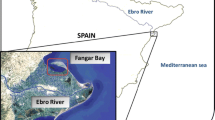Abstract
To determine the pharmacokinetics of a small lipophilic molecule in vivo, the distribution and accumulation of 99mTc-radiolabelled disofenin (diisopropylacetanilide iminodiacetic acid) were traced during 1991–1992 by scintigraphy and gamma well counting in winter flounder (Pleuronectes americanus collected from Boston Harbor and Long Island Sound in 1992), lobsters (Homarus americanus collected from Massachusetts Bay in 1991), and soft-shell clams (Mya arenaria purchased in 1991). The agent was distributed throughout the bodies of lobsters within 12 s, throughout flounder within 40 s, and throughout clams within 2 min. It was concentrated most strongly by the liver of flounder, which contained 61.2±7.8% of the injected dose within 1 h of injection, and by the lobster hepatopancreas. Accumulation also occurred in the flounder kidney, lobster antennal glands, and the kidney and pericardial glands of clams. The compound was rapidly excreted from the flounder liver into the gall bladder, and from the lobster hepatopancreas into the stomach. The data suggest its excretion from the lobster antennal glands and clam kidneys. The rate of clearance of disofenin from the body varied among species: 99±2.1% of the initial dose remained in flounder sampled 16 to 24 h after injection, compared to 80.5±7% remaining in the lobster after 15 h, and 87.4±5.9% remaining in clams after 27 h. The clearance rates in flounder and lobster are considered to be minimum values because of the lack of gut activity in unfed individuals. Overall, these in vivo tracer studies establish the utility of scintigraphy for assessing the uptake and excretion of a lipid soluble compound in different taxa, and may be applicable for evaluating disease and/or environmental effects on organ function in marine animals.
Similar content being viewed by others
Literature cited
Barker, P. L., Gibson, R. (1977). Observations on the feeding mechanism, structure of the gut, and digestive physiology of the European lobster Homarus gammarus (L.) (Decapoda: Nephropidae). J. exp. mar. Biol. Ecol. 26: 297–324
Bernier, D. R., Christian, P. E., Langan, J. K., Wells, L. D. (eds.) (1989). Nuclear medicine technology and techniques. C. V. Mosby Co., St. Louis
Burns, H. D., Marzilli, L. G., Sowa, D. T., Baum, D., Wagner, H. N. (1977). Relationship between molecular structure and biliary excretion of Tc-99m-HIDA and HIDA analogues. J. nuc. Med. 18: 624
Chilton, H. M., Witkowski, R. L. (1986). Nuclear pharmacy: an introduction to the clinical application of radiopharmaceuticals. Lea and Febiger, Philadelphia
Costello, C. E., Brodack, J. W., Jones, A. G., Davison, A., Johnson, D. L., Kasina, S., Fritzberg, A. R. (1983). The investigation of radiopharmaceutic components by fast atom bombardment mass spectroscopy: the identification of Tc-HIDA analogs. J. nuc. Med. 24: 2
Cuenot, L. (1893). Etudes physiologiques sur les Crustaces Decapodes. Archs Biol. 13: 245–303
Dall, W., Moriarty, D. J. W. (1983). Functional aspects of nutrition and digestion. In: Mantel, L. H. (ed.) The biology of Crustacea, Vol. 5. Internal anatomy and physiological regulation. Academic Press, New York, p. 216–261
Gardner, G. R., Yevitch, P. P., Harshbarger, J. C., Malcolm, A. R. (1991). Carcinogenicity of Black Rock harbor sediment to the eastern oyster and trophic transfer of Black Rock harbor sediments from the blue mussel to the winter flounder. Envir. Hlth Perspectives 90: 53–66
Gassner, G., Vogelbein, W., Line, M. (1992). Magnetic resonance detection of environmentally induced hepatic lesions in Fundulus heteroclitus. Mar. envirl Res. 34 (1–4): 7–11
Gibson, R., Barker, P. L. (1979). The decapod hepatopancreas. Oceanog. mar. Biol. A. Rev. 17: 285–346
Haya, K., Waywood, B. A., Burridge, L. E., Van Ecckhaute, L. (1985). Liver energy metabolism and gill ATPase activity of Salmo salar juveniles after exposure to sublethal levels of phenols. In: Vernberg, F. J., Thurberg, F. T., Calabrese, A., Vernberg, W. B. (eds.) Marine pollution and physiology: recent advances. Univ. of South Carolina Press, Columbia, p. 521–535
Hirsch, G. C., Jacobs, W. (1928). Der Arbeitsrhythmus der Mitteldarmdruse von Astacus leptodactylus. Z. vergl. Physiol. 12: 102–144
Krishnamurthy, G. T., Turner, F. E. (1990). Pharmacokinetics and clinical application of Technetium 99m-labelled hepatobiliary Agents. Semin. nuc. Med. 20 (2): 130–149
Loberg, M. D., Fields, A. T. (1978). Chemical structure of Tc-99m labelled N-(2,6-dimethylphenylcarbamoylmethy)-iminodiacetic acid (Tc-HIDA). Int. J. appl. Radiat. Isotopes 29: 167
Meyhofer, E., Morse, M. P., Robinson, W. E. (1985). Podocytes in bivalve molluscs: morphological evidence for ultrafiltration. J. Comp. Physiol. 156B: 151–161
Morse, M. P. (1987). Comparative functional morphology of the bivalve excretory system. Am. Zool. 27(3): 737–746
Murchelano, R. A., Wolke, R. E. (1991). Neoplasms and nonneoplastic liver lesions in winter flounder, Pseudopleuronectes americanus, from Boston harbor. Envir. Hlth Perspectives 90: 17–26
Myers, M. S., Landahl, J. T., Krahn, M. M., McCain, B. B. (1991). Relationships between hepatic neoplasms and related lesions and exposure to toxic chemicals in marine fish from the U.S. west coast. Envir. Hlth Perspectives 90: 7–15
Seiler, G. R., Morse, M. P. (1988). Kidney and hemocytes of Mya arenaria (Bivalvia): normal and pollution-related ultrastructural morphologies. J. Invertebr. Path. 52: 201–214
Stegeman, J. J., Kloepper-Sams, P. (1987). Cytochrome P-450 isoenzymes and monooxygenase activity in aquatic animals. Envir. Hlth Perspectives 71: 87–95
Stegeman, J. J., Woodin, B. R., Goksoyr, A. (1988). Apparent cytochrome P-450 induction as an indicator of exposure to environmental chemicals in the flounder Platichthys flesus. Mar. Ecol. Prog. Ser. 46: 55–60
Sulaiman, N., George, S., Burke, M. D. (1991). Assessment of sublethal pollutant impact in an industrial estuary using hepatic biochemical indices. Mar. Ecol. Prog. Ser. 68: 207–212
Author information
Authors and Affiliations
Additional information
Communicated by J.P. Grassle, New Brunswick
Rights and permissions
About this article
Cite this article
Burn, P.R., Potts, M.S., Moore, R.H. et al. Tissue distribution and excretion of 99mTc-disofenin in three marine species: Pleuronectes americanus (winter flounder), Homarus americanus (lobster), and Mya arenaria (soft-shell clam). Marine Biology 116, 355–361 (1993). https://doi.org/10.1007/BF00350052
Received:
Accepted:
Issue Date:
DOI: https://doi.org/10.1007/BF00350052




